|
TLC Tugger
The TLC Tugger is a tape-less restoration method. It consists of a two-layered plastic cone that the remaining foreskin is squeezed between. The cone is then attached to an elastic belt to provide tension. It has the convenience of not using tape, although like all tape-less methods, there is the discomfort associated with the foreskin being pinched as well as the concern over restricting blood flow. is a tape-less restoration method. It consists of a two-layered plastic cone that the remaining foreskin is squeezed between. The cone is then attached to an elastic belt to provide tension. It has the convenience of not using tape, although like all tape-less methods, there is the discomfort associated with the foreskin being pinched as well as the concern over restricting blood flow.
Pul-Man
The Pul-Man is virtually identical to the TLC Tugger.
CAT method
The CAT method (Constant Applied Tension) uses the CAT Stretcher , a tape-less device that clamps onto the remaining foreskin in much the same way as the TLC Tugger. It does not use an external source of tension to pull the foreskin. Instead, the device creates tension by pushing away from the glans penis. , a tape-less device that clamps onto the remaining foreskin in much the same way as the TLC Tugger. It does not use an external source of tension to pull the foreskin. Instead, the device creates tension by pushing away from the glans penis.
DTR method
The DTR method (Dual Tension Restorer) uses a device very similar to the CAT Stretcher and can work using the same pushing principle, but like the TLC Tugger, it can also be attached to an external source of tension. (Dual Tension Restorer) uses a device very similar to the CAT Stretcher and can work using the same pushing principle, but like the TLC Tugger, it can also be attached to an external source of tension.
MySkinClamp
The MySkinClamp device, like the DTR, uses a tape-less clamp and combines both pushing and pulling tension. device, like the DTR, uses a tape-less clamp and combines both pushing and pulling tension.
BUD method
There are several models of BUDs (British Uncircumcising Device). Most use weights (see the Weight-based methods page), but type E is a tape-less device similar to the MySkinClamp. (British Uncircumcising Device). Most use weights (see the Weight-based methods page), but type E is a tape-less device similar to the MySkinClamp.
PPB method
The PPB method (Powdered Pull Balls) uses a weight similar in style to Foreballs, except instead of using tape, it attaches using a tape-less clamp. (Powdered Pull Balls) uses a weight similar in style to Foreballs, except instead of using tape, it attaches using a tape-less clamp.
O-ring method
This method is only possible if you were circumcised loosely or have already restored a considerable amount of foreskin using some other method. It is essentially a form of tape-less ring-taping. The foreskin is pulled over the glans penis and held in place using rubber O-rings. It has the same shortcomings as ordinary ring-taping plus it can be difficult to find O-rings tight enough to retain the foreskin, but not so tight as to restrict blood flow.
Better Than O-Rings method
This is an adaptation of the O-ring method that, instead of using O-rings, uses short lengths of foam rubber tubing, such as the kind used for bicycle handlebar covers. As it can be cut to any length, only one tube needs to be worn -- unlike O-rings, where you may need to apply several.
Manual Restoration
Manual restoration uses no tape or devices of any sort. There are various methods , but all consist of gripping the foreskin and stretching it by hand. I personally am very skeptical of manual restoration's effectiveness, but some report success using the technique. , but all consist of gripping the foreskin and stretching it by hand. I personally am very skeptical of manual restoration's effectiveness, but some report success using the technique.
| 

